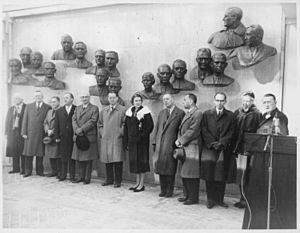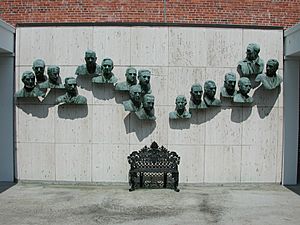Polio Hall of Fame facts for kids
The Polio Hall of Fame is a special monument that honors scientists and other people who helped fight poliomyelitis, also known as polio. It has 17 bronze statues, called busts, of these important individuals. You can find it on the outside wall of Founder's Hall at the Roosevelt Warm Springs Institute for Rehabilitation in Warm Springs, Georgia.
Contents
History of the Polio Hall of Fame

The famous sculptor Edmond Romulus Amateis designed the busts. They are made of bronze and placed on a white marble wall. The Georgia Warm Springs Foundation asked Amateis to create this Hall of Fame. It was made to celebrate the 20th birthday of the National Foundation for Infantile Paralysis.
The monument was officially opened on January 2, 1958. The artist and almost all the living scientists honored were there. Eleanor Roosevelt, the wife of the late President Franklin D. Roosevelt, also attended. She represented her husband at the ceremony.
Who is Honored in the Hall of Fame?
The Polio Hall of Fame features 17 busts. The first 15 honor scientists who were key in researching and treating polio. These include 14 men and one woman. The last two busts are of Franklin D. Roosevelt and his close helper, Basil O'Connor.
The first four honored individuals are European pioneers in polio research. They are Jakob Heine from Germany, Karl Oskar Medin and Ivar Wickman from Sweden, and Karl Landsteiner from Austria. Landsteiner also won a Nobel Prize. The remaining 13 individuals, from number 5 to 17, are Americans. The busts are not placed in strict date order.
| No. | Name | What they did |
|---|---|---|
| 1 | Jakob Heine (1800-1879) | First described infantile paralysis in 1840. |
| 2 | Karl Oskar Medin (1847-1927) | Showed that polio was an acute infection in 1890. |
| 3 | Ivar Wickman (1872-1914) | Discovered that polio spreads in epidemics (1907). He also showed that many people had polio without showing paralysis. |
| 4 | Karl Landsteiner (1868-1943) | Discovered the poliovirus and showed it could be passed to monkeys. |
| 5 | Thomas Milton Rivers (1888-1962) | Chaired the committee that planned the successful 1954 polio vaccine trials. |
| 6 | Charles Armstrong (1886-1967) | Discovered in 1939 that poliovirus could infect cotton rats. |
| 7 | John R. Paul (1893-1972) | Made important discoveries about how polio spreads. |
| 8 | Albert Sabin (1906-1993) | A leader in developing a live virus vaccine for polio. He created the oral vaccine, which was cheaper and easier to use. |
| 9 | Thomas Francis, Jr. (1900-1969) | An expert who confirmed how effective the Salk vaccine was. |
| 10 | Joseph L. Melnick (1914-2001) | Developed ways to measure immunity in groups of people exposed to the virus. |
| 11 | Isabel Morgan (1911-1996) | Created an experimental vaccine that protected monkeys from paralytic polio. |
| 12 | Howard A. Howe (1901-1976) | The first to show that chimpanzees could get polio by mouth. He also tested a treated vaccine on humans. |
| 13 | David Bodian (1910-1992) | Showed that the virus enters the bloodstream before reaching the brain and spinal cord. This meant antibodies in the blood could stop it. |
| 14 | John F. Enders (1897-1985) | Found a way to grow polio viruses in lab cultures. This made it possible to produce a safe and effective vaccine in large amounts. |
| 15 | Jonas E. Salk (1914-1995) | Developed the famous Salk vaccine. |
| 16 | Franklin D. Roosevelt (1882-1945) | Founded the Warm Springs Foundation in 1927 and the "National Foundation for Infantile Paralysis" in 1938. |
| 17 | Basil O'Connor (1892-1972) | Led the fight against polio. He was president of the National Foundation for Infantile Paralysis from 1938. |
Franklin D. Roosevelt and Warm Springs
Franklin D. Roosevelt, who became the 32nd U.S. President, often visited Warm Springs starting in 1924. He later passed away there in 1945. In August 1921, he became very ill with a paralytic illness, which doctors at the time said was polio. This happened while he was on vacation with his family. Roosevelt was left permanently paralyzed from the waist down. He could not stand or walk without help.
In 1927, Roosevelt started the Georgia Warm Springs Foundation. This foundation created a center that is now called the Roosevelt Warm Springs Institute for Rehabilitation. It is a special facility run by the state of Georgia. It helps people recover from injuries and illnesses. It also offers job training and care for people with conditions like post-polio syndrome, spinal cord injuries, and brain damage.
Images for kids






